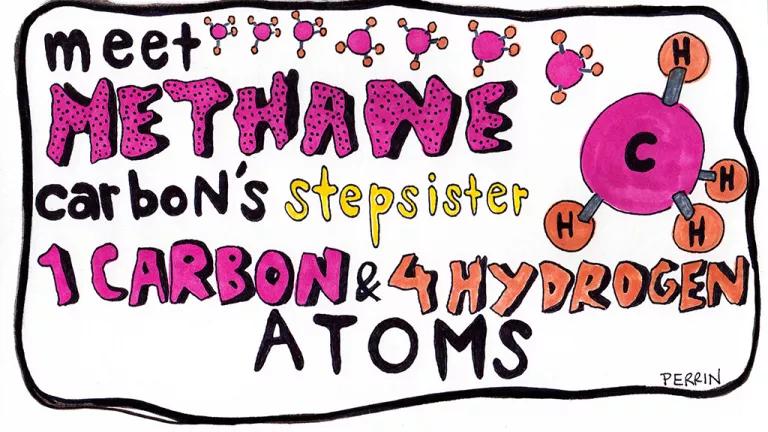Mo Methane, Mo Problems
When it comes to harmful greenhouse gases, methane’s some pretty potent stuff. Here’s why.

Since late October, an underground storage facility in the Los Angeles suburb of Porter Ranch has been leaking some 800 tons of methane into the air each day. As thousands of residents are evacuated and kids are temporarily forced to attend different schools, the leak is making headlines across the country.
Most of the stories out there mention that methane is a potent greenhouse gas. Some go on to explain that the leak is now California’s biggest climate change contributor. But none of the coverage I’ve seen explains what exactly makes this gas worse than others. So I tracked down a few experts to help me understand what those methane molecules actually do to the atmosphere. Here’s what I learned.
According to Drew Shindell, a professor of climate sciences at Duke University’s Nicholas School of the Environment, three factors determine the power of a gas to alter the earth’s climate: how efficiently it absorbs heat, how long it lasts in the atmosphere, and how much of it is present. As it turns out, methane performs pretty well on all fronts.
The earth is able to support life because it reflects, via clouds and snow, enough of the sun’s rays (or light, or heat, or energy—call it what you will) to keep us from burning up. The atmosphere also traps some of those rays and warms the planet so we can grow plants, microbes, and human babies. It’s a perfect little balance.


The atmosphere is full of floating molecules—like water and carbon—that absorb much, but not all, of the energy emanating off the earth. Some of those energy wavelengths fall into a “window region,” a frequency that many molecules in the atmosphere can’t easily soak up. This energy is able to shoot back into space, undeterred, as if passing through a door or window.
But methane is an exception—it can absorb energy wavelengths within the window region. The atmosphere doesn’t typically contain a whole lot of methane, compared with carbon dioxide or water vapor. But when methane is present in large amounts, the atmosphere can trap a lot more heat than usual, explains Neil Donahue, an atmospheric chemist from Carnegie Mellon University. When extra methane is being emitted, especially at the rates coming out of Porter Ranch—about 66,000 pounds of methane per hour—it means there’s essentially another beefy bouncer at the door preventing heat from entering space.

As for how long it persists in the atmosphere—Shindell’s second factor for determining a gas’s climate-influencing power—methane has a relatively short life span before it shape-shifts. It stays a methane molecule for about two decades (a brief sojourn compared with that of CO2, which has the ability to last for millennia).
The problem with methane is that it eventually reacts with oxygen in the atmosphere and forms … carbon dioxide. “It stays there as carbon,” says Donahue. And by “stays there,” he means indefinitely—“for like 800 years to hundreds of thousands of years.” Methane as such may not last very long, but by converting into carbon dioxide, it becomes a persistent force for global warming.

Which brings us to the third factor: How much of the gas is being emitted? Given that the Porter Ranch leak is a single source of methane, it might not seem as if it would play a huge role in global climate change, but its rate of release is not insignificant. Nathan Phillips, director of the Sustainable Neighborhood Lab at Boston University, studies active methane leaks from decaying pipelines under Boston’s streets, and he has found that the city’s 3,365 leaks add up to about 10 percent of Massachusetts’s annual greenhouse gas emissions. According to Phillips, the Porter Ranch storage facility is emitting more methane than that, by many factors of 10. In three months, the Porter Ranch has already released what the California Air Resources Board estimates to be 4.6 percent of California’s average annual methane emissions—and 25 percent of the state’s daily greenhouse gas emissions.
More methane in the atmosphere can bring warmer temperatures, decreased agricultural yields, and more damaging storms, wildfires, and heat waves in the years that follow. Shindell calculates that the amount of methane estimated to have already escaped from Porter Ranch will cost California from $200 million to $500 million in damages in coming decades.
While Porter Ranch is definitely a crisis in the making, it’s important not to forget the cumulative climate impacts of all those other ongoing, albeit smaller, leaks happening across the country as a result of decaying and faulty infrastructure. Because as you (and I) now understand: Methane packs quite a climate punch.
This article was originally published on onEarth, which is no longer in publication. onEarth was founded in 1979 as the Amicus Journal, an independent magazine of thought and opinion on the environment. All opinions expressed are those of the authors and do not necessarily reflect the policies or positions of NRDC. This article is available for online republication by news media outlets or nonprofits under these conditions: The writer(s) must be credited with a byline; you must note prominently that the article was originally published by NRDC.org and link to the original; the article cannot be edited (beyond simple things such grammar); you can’t resell the article in any form or grant republishing rights to other outlets; you can’t republish our material wholesale or automatically—you need to select articles individually; you can’t republish the photos or graphics on our site without specific permission; you should drop us a note to let us know when you’ve used one of our articles.

Liquefied Natural Gas 101
The Uinta Basin Railway Would Be a Bigger Carbon Bomb Than Willow
How to Ditch the Biggest Fossil Fuel Offenders in Your Life